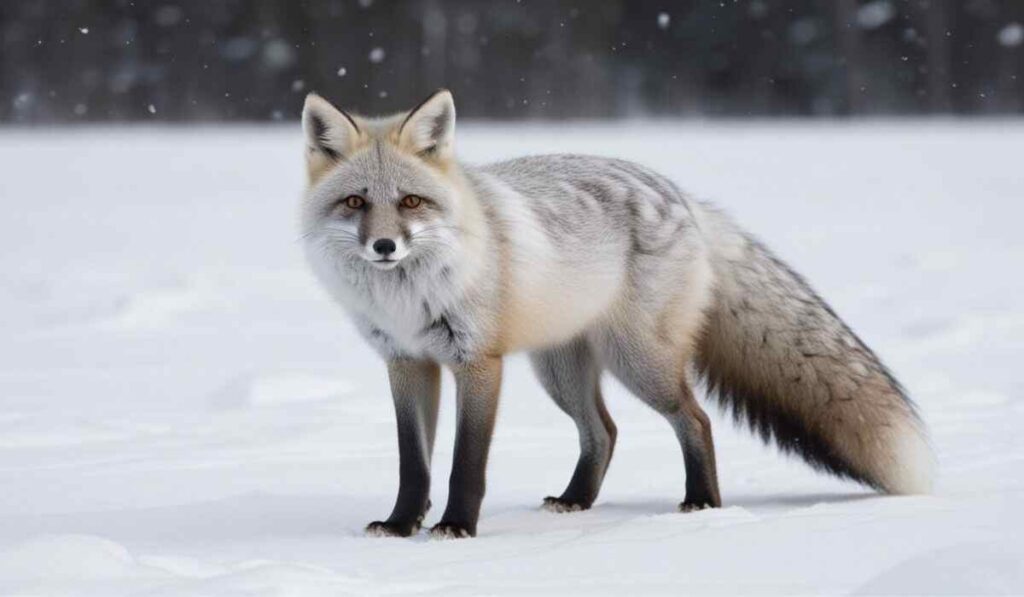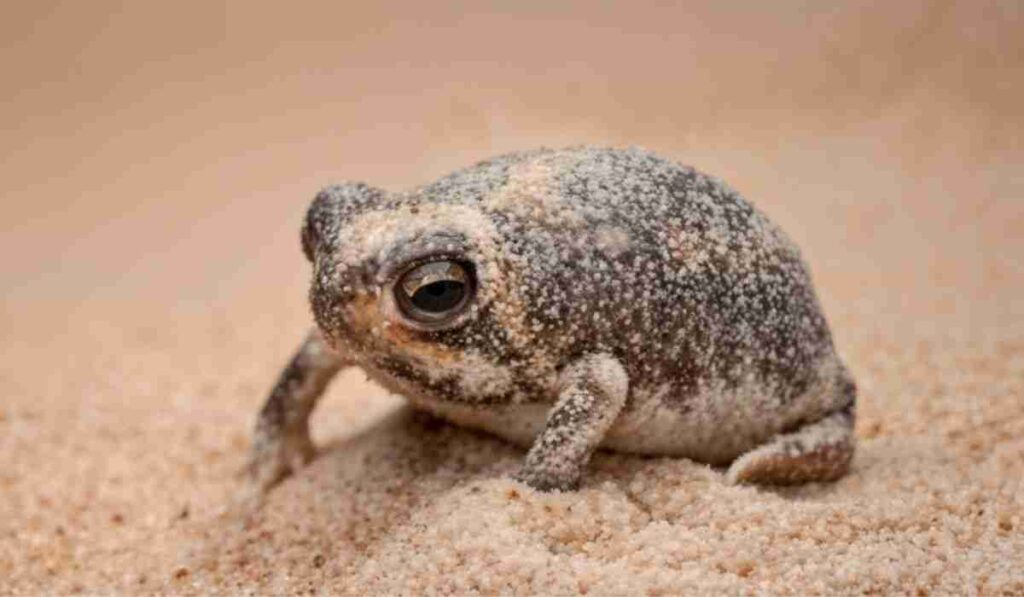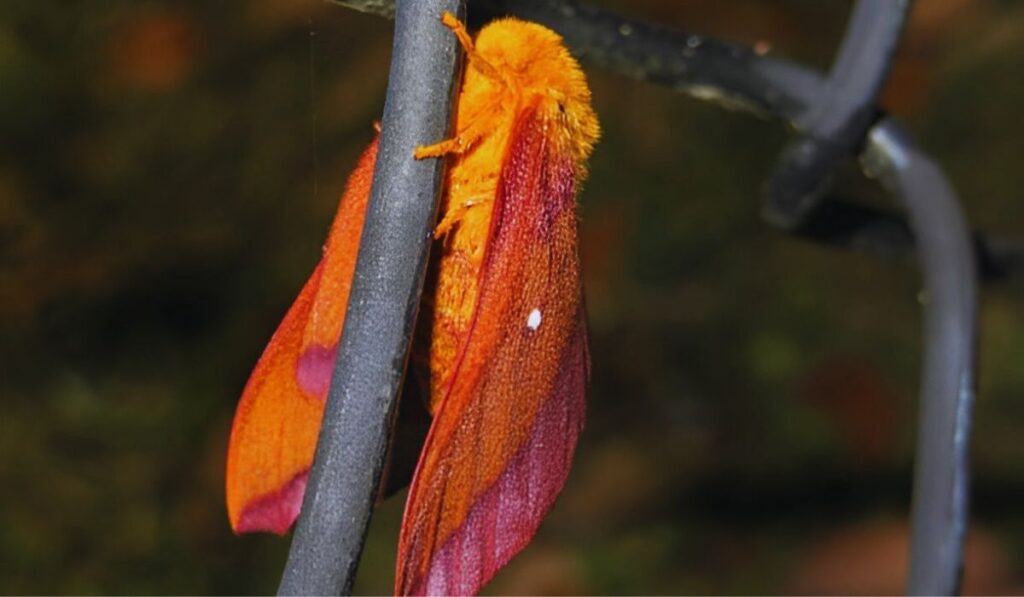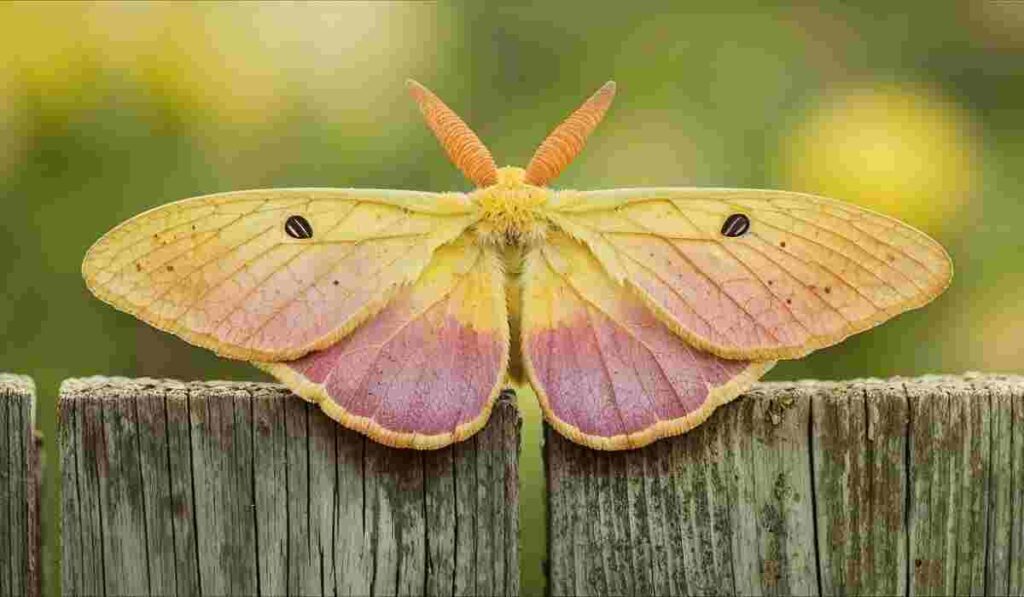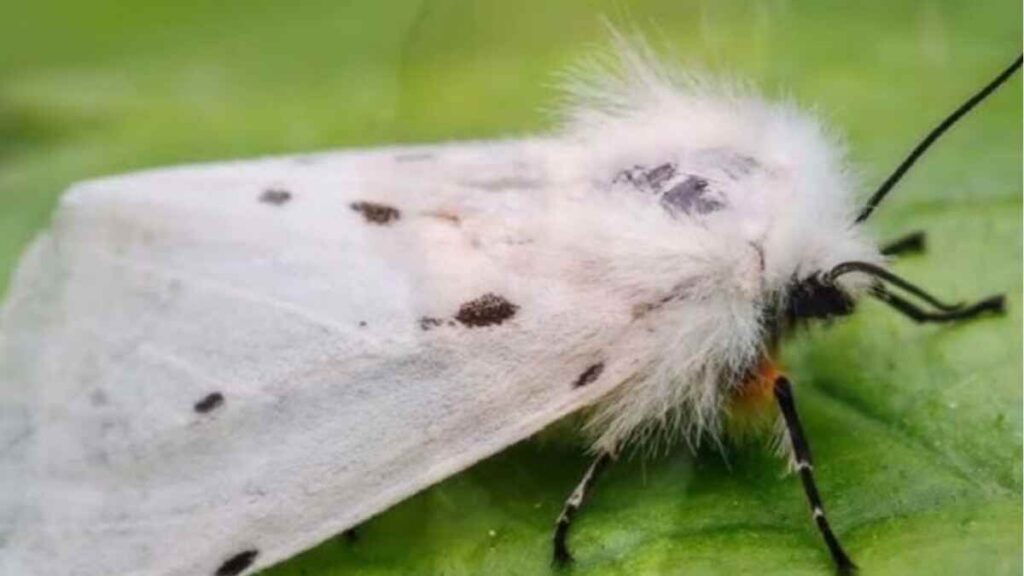History Tolype Moth
Caspar Stoll formally described the Tolype Moth in 1791. It is found all over North America, from Nova Scotia, down to Florida, in addition to Texas, Ontario, and even the California Mountains. This moth, with its soft, gray wings and furry body, is easy to identify. It is very adaptable, which is why it can be found in many different places. Its life cycle, habitat, and role in nature are studied by scientists. Nowadays, scientists keep tabs on the moth population. It is studied by scientists to learn about the life cycles of moths and the health of forests.
Physical Characteristics between Tolype Moth
| Size (Males) | 11–12 mm |
| Size (Females) | 16 mm |
| Weight | 0.05 to 1.9 grams |
| Wingspan | 3.2 to 5.8 cm (1.2 to 2.3 inches) |
| Color & Shape | Mostly white or grayish-white body with dark markings on wings |
| Wings | Soft, gray wings with white veins and lines |
| Eyes | Big eyes |
| Nose | No nose |
| Tail | Short, furry tail that helps it stay warm |
| Patterns | Fuzzy body with prominent hair-like scales |
| Top Speed | Not a fast flier |
| Eggs Laid | Usually laid in clusters on host plants |
| Body Temperature | Warms up its body before flying |
| Flight Period | September – October |
| Location | Eastern North America (Nova Scotia, Florida, Minnesota, Nebraska, Texas) |
Interesting Facts About Tolype Moth
Tolype Moth caterpillar
It is furry and soft. It has gray, brown or white hairs covering its body. Its hair protects it from predators. The caterpillar feeds on leaves, including those of oak, apple, and cherry trees. It slowly grows before fashioning a cocoon. It then morphs into a moth on the inside.
If you see it, it’s often on trees or plants. While it may look adorable, it has hairs that can irritate the skin. Because of this caterpillar, it is food for birds and insects. They want to study ecosystem shifts and observe how these moths contribute to biodiversity.
Life Cycle of the Tolype Moth
Tolype Moth larvae Stage
It feeds on the leaves of oak, birch, ash, apple, and poplar trees. They are dark gray with small flaps of skin on their legs. As it matures, the flaps degrade. The larvae emerge from June through August and camouflage on trees to avoid detection. It has an important function in nature because it is food for birds and other animals.
Tolype Moth Egg Stage
It deposits small oblate, or round, eggs on leaves and branches. She lays them in clutches and they are protected. Those eggs require protection from the rain, the wind, and predators.
In a while, the caterpillars hatch from the eggs, marking the beginning of the life cycle. They grow with the right temperature and humidity. By studying these eggs, scientists gain insight into how moths survive and the changes in their populations.
Caterpillar Stage
The Large Tolype, or Tolype velleda, is a type of moth whose caterpillar, or larval stage, is vital to a complete life cycle. This stage has distinctive physical characteristics and habits that prepare it to become a mature moth.
This stage occurs primarily between June and August. The caterpillar feeds upon various broadleaf trees and shrubs during this period. These plants play an important role in its growth and subsequent change.
Pupa Stage
The Tolype moth (Tolype velleda), also called the large tolype moth or velleda lappet moth. This Species is from the family called Lasiocampidae. As a pupa it snuggles in a cocoon. Within its body, it transforms entirely.
As the caterpillar’s body transforms, legs, wings, and antennae are formed. This can last weeks or months depending on weather. It is safe in the cocoon(particularly from its predators and adverse conditions).
(silent growth, no eating involved) When the adult moth is ready, it breaks free. This resting phase is critical for its survival. Farfmers occasionally see these cocoons on trees or leaves. Each pupa contains a future moth, which soon will break free.
Adult Moth Stage
The adult Tolype moth emerges from its pupal casing to begin life anew. Males and females have different appearances. Females are larger and paler than their smaller, darker mates.
Wingspan from 26 to 58 mm. These moths were furry, and fluffy, and help to keep them nice and warm. They are nocturnal, flying to locate mates. Adults do not eat because they are potently driven by the desire to reproduce.
Tolype moth species
Tolype has many varieties, and all look and behave differently. Tolype velleda, with its fuzzy gray wings and white body, is a familiar species that specializes in the leaves of other trees. Another is Tolype laricis, which lives in forests with pine and larch trees.
Some species like warmer locations, some reside in cooler areas. Indeed, these moths are primarily nocturnal, and their coloration helps them avoid predators.
Difference Between Tolype Moth and Caterpillar
The Tolype Moth and its caterpillar have very different appearances. Its wings are gray or brown, with white wavy lines. (The wingspan is 1¼ to 2¼ inches.) The caterpillar, which is covered in long hairs, is gray or brown.
The moth flies, the caterpillar crawls and eats leaves. Over time, the caterpillar forms a cocoon and turns into a moth. Both are part of the same life cycle but have different shapes and behaviors.
Habitat
It inhabits forests and cities throughout North America, from Nova Scotia to Texas. Feeding on Apple, Ash, Beech, Birch, Elm, Maple, Oak, Poplar, and fruit trees, providing food and shelter. This moth, which is very common in places that have a lot of trees, is studied by scientists in order to understand its role in the environment.
Feeding habits
Tolype moth caterpillars are voracious feeders! They feed on foliage from trees such as apple, oak, birch, elm and plum. Their powerful jaws allow them to munch their way through tough leaves, and they get bigger each day. These caterpillars are active in summer, feeding at night and seeking shelter during the day.
But when they emerge and become adult moths, they no longer eat. Adult Tolype moths possess no functional mouthparts and so exist merely to copulate and deposit eggs. Moths have a short lifespan, keeping the cycle lively. That guarantees that new caterpillars hatch and start feeding again.
Predator
It has many natural enemies. It is preyed upon for food by birds, bats, and spiders. They help the moth’s population remain in balance. Eggs and caterpillars are also attacked by parasitic wasps and flies. They prevent the moth from developing into an adult moth.
During the night they are searching for and hunting flying moths using echolocation. Birds see them on trees during the day and eat them. Some small mammals also eat moths. Nature balances itself, and Tolype Moth populations are controlled by predators.
Care
Tolype Moth Care
It is easy to care for a Tolype Moth but does take some care. Direct contact should be avoided as these moths have tiny hairs, which may irritate the skin. Make sure to always treat them delicately with a soft brush or jar.
How to Care:
- Safe Handling – A container instead of hands.
- Proper Habitat – Store in a cool dark area with fresh leaves.
- Limited Touch – Handle infrequently to limit stress.
- JUST WATCH – You can watch them, but don’t touch their wings.
Giving a tranquil, natural environment helps them thrive without harm.
Type Moth Territoriality
It is found in North America, Europe, and Africa. It will adapt to various locations, such as forests, gardens, etc. These moths are free-ranging, unlike some insects that defend territories. Instead, they roam widely in search of food and mates. Its habitat evolves with the season and food availability. It lays eggs on trees where the larvae develop. It survives in different spaces Scientists study their movements.
Larch Tolype Moth
The North American fuzzy, small moth is known as the Larch Tolype Worry moth. It lives in forests containing larch trees, and its caterpillars feed on their leaves. This moth has soft patterning on its gray wings that helps it blend in with tree bark. During the day, it flies to search for food and mates.
Scientists study it to figure out forest health and what moths do for nature. Birds and other wildlife consume them, so they are an integral part of the food that other wildlife eats. People often see them resting on trees, their colors hiding them from danger.
Small Tolype Moth
The Small Tolype Moth (Tolype notialis) is a small, fuzzy kind of moth belonging to the Lasiocampidae family. It is similar in appearance to the Large Tolype Moth (Tolype velleda) but is smaller and has a different coloration. One of the final moths for the fall season is this one, which resides in North America but mostly in warmer regions. It emerges at night and is attracted to lights. Its gray wings help it blend in with trees.
The caterpillars consume oak and other leaves. They are important because they feed birds and other animals, helping to sustain nature. Popular opinion may steer people away from moths, due to their colorless appearance and sometimes ruined clothing animals. Scientists study them to learn more about moths and their role in the ecosystem.
Male vs Female Tolype Moth
Southern Tolype Moths have sexual dimorphism! Males are smaller, darker, and have fluffy gray-white wings and bushy antennae to locate females. Females are larger, and lighter, have pale brownish-gray wings, and have simpler antennae. These moths inhabit forests and gardens, taking to the air by night. These sweet creatures fly around having what seems to be a good time — as their furry bodies may make them appear like small flying teddy bears!
Tolype Moth diet

It eats leaves. Its caterpillar feeds on oak, apple, cherry, and maple trees. These leaves help it grow. At night, it munches on fresh, tender leaves. Adult moths do not eat. It has a short adult life and can only mate and lay eggs during that time. Its diet helps preserve forests by cycling nutrients.
Southern Tolype Moth
The Southern Tolype Moth (Tolype minta), is a fluffy gray-white moth of forests and gardens. It has large wings with dark spots and flies at night. Its larvae feed on leaves, but moths do not feed. They are hunted by birds and bats, so their role is quite essential. These moths flicker in lights, a ghostly presence!
Anderillium Tolype Moth warm
Anderillium Tolype Moth is a big fan of warm nights! With delicate gray-brown wings shot with wavy patterns, it flutters around trees in search of mates. Females are detected by males using feathery antennae.
These moths subsist on nothing—they exist to procreate! Their fuzzy bodies hold heat in and keep them warm. During their caterpillar stage, the larvae feed on oak, maple, and apple leaves, camouflaging themselves into tree bark. When they shed their skin, they spin a silky cocoon, and later become a moth.
Is Tolype harm
It is mostly harmless, but its larvae can cause mild skin irritation or itchiness, especially for people with sensitive skin or allergies. This happens when touching its tiny hairs, but the reaction is not serious and fades on its own. The moth does not bite, sting, or spread diseases. Though it looks soft and fuzzy, it’s best to avoid touching the larvae to prevent irritation.
Tolype Velleda Moth
The Tolype Velleda Moth (also known as the Large Tolype Moth) is a big gray fancy, fuzzy moth native to North America It was first identified by Caspar Stoll in 1791. This moth dwells in forests, where it feeds on oak and apple trees. It has fuzzy, gray wings with white flecks and a hairy body. It flies in lights at night. Its caterpillars consume leaves, but do no damage to the forests, helping to support wildlife.
What is the mutation Tolype Moth?
Tolype Moth mutation refers to a small change in its genome. This can influence the color, size, or wings. Some mutations allow it to evade predators and others weaken it. Mutations will occur as the result of weather, predators, or environment. These changes are what scientists study to learn about how the moth adapts and survives. Understanding mutations can also protect these moths and their habitats, researchers say.
Tolype Moth in Nova Scotia
It flourishes in Nova Scotia’s mixed woods. These fuzzy, gray-brown moths are most often seen in July and August. The caterpillars eat local trees including birch, maple, and oak. The cocoons last the winter crammed into bark crevices. The cool summers of Nova Scotia spare the moths deadly heat.
Look for them at night around porch lights or woodland edges. Its thick scales also maintain heat in the maritime climate. Harmless in moderation, but if infested heavily, trees may become stressed, especially younger trees. The moths have their place in the food chain, as food for birds and bats.
South Carolina
The Velleda Lappet Moth, Tolype velleda, this species inhabits the forests and woodlands of South Carolina. This moth basks in warm climates and is commonly found in the vicinity of oak, maple, and other broadleaf trees. Its caterpillars eat leaves and develop into fuzzy gray larvae before spinning cocoons.
Adults emerge in late summer and autumn, flying at night in search of mates. Their fuzz is a defense mechanism against predators. A state of mild winters and lush forests. This makes it an excellent home for these moths, allowing them to thrive year-in and year-out.
Uk or united kingdom
It is not native to the UK. The Large Tolype Moth (Tolype velleda) found in North America. It stretches from Canada all the way down to Florida. These moths prefer forests featuring oak, maple and birch trees. These trees are commoner where they come from. There are similar fuzzy moths in the UK, but no Tolype species have been noted.
If they are introduced, they may struggle to survive. That is due to varying climates and sources of food. Not present in the UK, but moth enthusiasts can discover what these creatures get up to and their place within North American woodland.
What Difference between the Venezuelan Poodle moth, Rosy maple moth, and the Pink-Striped Oak Worm Moth and Tolype Moth?
The Venezuelan Poodle Moth is a fictional species. It is a name that exists only in an alternate universe of fiction or, at worst, muddled memory. It is sometimes said to resemble a fluffy white moth, though no verifiable scientific records exist.
The Rosy Maple Moth is an actual silk moth with vibrant pink and yellow wings. It is tiny and dwells in North America, mainly around maple trees. The caterpillars feed on maple leaves, but the adult moths do not feed at all.
The Pink-Striped Oak worm Moth is, again, a real species. Females are orange-edged with purple, and males are dark brown flecked with red and white. Their caterpillars consume leaves of oak, chestnut, and maple.
The Tolype Moth, the real white moth with fluffy gray wings. It is bigger than some moths, and its caterpillars camouflage themselves with tree bark. It grows in many places with an ethereal beauty.
Scientific Classification of the Tolype Moth
| Category | Details |
|---|---|
| Scientific Name | Tolype velleda |
| Subfamily | Poecilocampinae |
| Genus | Tolype; Hübner |
| Family | Lasiocampidae |
| Species | T. velleda |
| Class | Insecta |
| Domain | Eukaryota |



